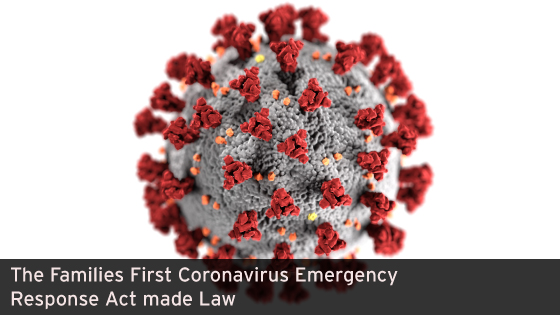The Families First Coronavirus Emergency Response Act made Law- Providing emergency sick leave and family medical leave and allowing for tax credits to employers and the self-employed.
The Families First Coronavirus Emergency Response Act was signed into law by President Trump on March 18, 2020 and will go into effect April 2, 2020. The law is intended to provide emergency paid sick leave and expands the Family Medical Leave Act to make more families eligible for leave in the wake of the ongoing coronavirus pandemic. The Act also allows for payroll tax credits for employers and credits for the self-employed to help cover the mandated paid sick and family medical leave costs.
The Act will affect businesses with under 500 employees, with some limitations on benefits provided to healthcare workers and emergency responders. However, there are provisions in the law that would allow for FUTURE regulations that would exempt certain employers with under 50 employees from the family medical leave portion of the law. The potential exemption would apply if providing the family medical leave would jeopardize the business. The potential exemption would also provide an exemption to employers from providing emergency paid sick leave based on caring for a child if the child’s school or place of care has closed. Regulations concerning these exemptions for businesses under 50 employees have not been released as of March 21, 2020. Details are expected over the next week.
EMERGENCY PAID SICK LEAVE
1. The Act requires mandatory paid sick leave. It is limited to $511 per day for up to 10 days for an eligible employee in a coronavirus quarantine or seeking a diagnosis. The emergency sick leave amount is up to $200 per day for up to 10 days to care for a quarantined family member or child whose school or childcare location has been closed due to coronavirus. There is no requirement that employee was employed for any number of days for this to apply. We do not know what proof will be required to document any of this at this time. DOL is expected to put something out soon.
2. Applies to all private employers with less than 500 employees and all government employers.
3. All employees are covered regardless of the length of their employment with the current employer. Strangely, employers may choose not to provide paid sick leave to employees who are healthcare providers or emergency responders.
4. Part-time employees are eligible based on the average number of hours they work over a two-week period.
5. Paid sick leave can be used when the employee-
a. Is subject to a federal, state or local quarantine or isolation order related to coronavirus
b. Has been advised by a healthcare provider to self-quarantine due to concerns related to coronavirus
c. Is experiencing symptoms of coronavirus and is seeking medical diagnosis
d. Is caring for an individual who is subject to a quarantine or has been advised by healthcare provider to self-quarantine
e. Is caring for his or her child if the child’s school or place of care has closed or the care provider is unavailable due to coronavirus concerns.
f. Is experiencing another substantially similar condition specified by HHS Secretary.
6. No details on what is required in terms of documentation at this time.
EMERGENCY FAMILY AND MEDICAL LEAVE
1. It requires that small business employees be given the right to take up to 12 weeks of job protected family leave if the employee or family member is in coronavirus quarantine or if the school or child-care for the child of the employee is closed due to coronavirus. The employer must pay at least 2/3 of the employee’s normal pay up to a maximum of $200 per day. These payments are subject to $10,000 in total family leave payments.
2. Applies to private employers with less than 500 employees and all government employers.
3. Employees that have worked for the current employer for 30 calendar days are eligible. Employers are permitted to deny coverage to healthcare providers and emergency responders.
4. Twelve weeks of family medical leave may be taken if the employee is unable to work (or telework) because they must care for a son or daughter under 18 years of age. The need for leave must be due to the closing of the child’s school or place of care or the unavailability of the care provider due to a declared coronavirus emergency. If an employee can telework or work from home to perform the duties of their job, the family medical leave wouldn’t apply.
5. Employers are not required to pay employees for the first 10 days of the new family medical leave, but employees can use accrued sick time or other paid leave.
6. Special rules apply for employees with variable schedules and for those subject to collective bargaining agreements.
7. Job protection- Under FLMA, leave is usually job protected which means employees must be restored to their position or similar when they return to work. This new law provides a limited exception to this requirement—Employers with fewer than 25 employees are not subject to job restoration if—
a. The employee took FMLA leave under the coronavirus expansion of the law
b. The employee’s position no longer exists due to economic changes or changes in the operating conditions of the employer that affect employment caused by public health emergency
c. The employer makes reasonable efforts to restore employee to an equivalent position
d. If the employer makes reasonable efforts to contact employee if an equivalent position becomes available within a year.
8. No details in terms of what is required for documentation at this time.
TAX CREDITS AND RELIEF TO EMPLOYERS PROVIDING THE REQUIRED LEAVE
Employers
1. The Act grants a new tax credit to small employers to cover the required payments (sick leave and family medical leave) to employees. The employer can take a 100% tax credit for applicable payments made against the Social Security component of his business payroll taxes. This credit only covers payments made beginning 15 days after the enactment date of March 18, 2020 which means that only payments made on or after 4/2/20 would be eligible. At this time, it is unclear what adjustments, if any, will be made for payments made prior to April 2, 2020.
The credit will first offset the Social Security component of their payroll taxes and any excess credit is refundable so the employer will get a refund for any of the excess. This credit is not available for employers already taking the existing credit for paid family and medical leave. The credit will only apply through December 31, 2020.
2. Sick leave and family leave payments mandated under the Act are exempt from the Social Security portion of the payroll tax. Medicare tax portion 1.45% must be paid but a credit will be available for the payment.
3. The IRS is expected to provide additional guidance, examples and methods of expediting refunds related to the allowable credits. IRS has stated it is committed to getting the funds into the employer’s hands as quickly as possible.
Self-Employed
1. Self-employed individuals affected by the coronavirus situation are also allowed to claim credit against their personal tax bill for 2020 including self-employment tax. This credit will also be refundable.
2. The credit will equal 100% of the self-employed persons sick leave equivalent plus 67% of the sick leave equivalent for taking care of a sick family member or taking care of your child following the closing of daycare/school.
3. The sick-leave equivalent equals the lesser of your average daily self-employment income or the same $511 per day for the same 10 day period as employees to care for the self-employed person or $200 per day for up to 10 days to care for a sick family member or child whose school is closed.
4. In addition, self-employed individuals could also claim coronavirus emergency family-leave credit for 50 days. It would equal the number of qualified family medical leave days multiplied by the lesser of $200 or your average SE income subject to a maximum of $10,000.
The Act also includes increases in federal payments to state for Medicaid as well as providing additional unemployment benefits in the form of grants to the states to cover additional costs and claims.
There are many aspects to the Act and additional guidance is almost certainly expected in the days to come. This is a lengthy piece of legislation that was hastily assembled to provide relief as quickly as possible to affected Americans- employers, employees and the self-employed. We will continue to monitor the legislative landscape as it continues to quickly evolve and keep our clients and friends up to date.
If you have any questions concerning the Act, please contact your Maillie LLP representative via phone or email.





